MG 34
The Maschinengewehr 34, or MG 34, is a German recoil-operated air-cooled machine gun, first tested in 1929, introduced in 1934, and issued to units in 1936. It introduced an entirely new concept in automatic firepower – the Einheitsmaschinengewehr (Universal machine gun) – and is generally considered the world's first general-purpose machine gun (GPMG).[4][5][6][7]
| Maschinengewehr 34 | |
|---|---|
 MG 34 in the Swedish Army Museum. | |
| Type | General-purpose machine gun |
| Place of origin | Nazi Germany |
| Service history | |
| In service | 1936–1945 (officially, German military) 1936–present (other armies) |
| Used by | See Users |
| Wars | World War II Chinese Civil War First Indochina War 1948 Arab–Israeli war Korean War Portuguese Colonial Wars Algerian War Cuban Revolution Suez Crisis[1] Biafran War Vietnam War Angolan Civil War Six-Day War The Troubles Syrian Civil War[2] |
| Production history | |
| Designer | Heinrich Vollmer |
| Designed | 1934 |
| Manufacturer | Rheinmetall-Borsig AG Soemmerda, Mauserwerke AG, Steyr-Daimler-Puch AG, Waffenwerke Brünn |
| Unit cost | 312 RM (1944) 1070 EUR current equivalent |
| Produced | 1935–1945 |
| No. built | 577,120[3] |
| Specifications | |
| Mass | 12.1 kg (26.7 lb) 32 kg (70.5 lb) (with tripod) |
| Length | 1,219 mm (48.0 in) |
| Barrel length | 627 mm (24.7 in) |
| Cartridge | 7.92×57mm Mauser |
| Action | Open bolt, Recoil-operated, Rotating bolt |
| Rate of fire | 800–900 rounds/min Early versions: 600–1000 rounds/min selectable on pistol grip MG 34"S": 1,700 rounds/min. MG 34/41: 1,200 rounds/min. |
| Muzzle velocity | 765 m/s (2,510 ft/s) (s.S. Patrone) |
| Effective firing range | 200–2,000 m (219–2,187 yd) sight adjustments 3,500 m (3,828 yd) with tripod and telescopic sight |
| Maximum firing range | 4,700 m (5,140 yd) |
| Feed system | 50/250-round Patronengurt 33, 34, or 34/41 model belt, 50-round drum, or 75-round drum magazine with modification |
| Sights | Iron sights, antiaircraft sight or telescopic sights |
The versatile MG 34 was chambered for the full-power 7.92×57mm Mauser rifle cartridge, and was arguably the most advanced machine gun in the world at the time of its deployment.[8] The MG 34 was envisaged and well developed to provide portable light and medium machine gun infantry cover, anti-aircraft coverage, and even sniping ability. Its combination of exceptional mobility – being light enough to be carried by one man – and high rate of fire (of up to 900 rounds per minute) was unmatched.[8] It entered service in great numbers from 1939. Nonetheless, the design proved to be rather complex for mass production, and was supplemented by the cheaper and simpler to mass produce MG 42, though both remained in service and production until the end of the war.
History
Before World War I
Even before World War I, the German military was already looking forward to replacing the heavy machine guns which proved to be such a success in that war. The MG13 was one of the first developments toward a goal of producing a weapon that could perform multiple roles, rather than just one. The MG13 was the result of reengineering the Dreyse Water-cooled machine gun to fit the new requirement.[9] The twin-barreled Gast gun was developed with the goal of providing a high cyclic rate of fire weapon for anti-aircraft use which was reported to have reached cyclic rates of fire as high as 1,600 rounds per minute.[9]
The Einheitsmaschinengewehr concept required the operator could radically transform the machine gun for several purposes by changing its mount, sights and feed mechanism. One of the Einheitsmaschinengewehr roles was to provide low-level anti-aircraft coverage. A high cyclic rate of fire is advantageous for use against targets that are exposed to a general-purpose machine gun for a limited time span, like aircraft or targets that minimize their exposure time by quickly moving from cover to cover. For targets that can be fired on by a general-purpose machine gun for longer periods than just a few seconds, the cyclic firing rate becomes less important.
After World War I
After World War I the German military faced restrictions imposed by the Treaty of Versailles. The treaty restricted the German Reichswehr (Realm Defence) to maximally stockpiling 792 heavy (bulky hard-to-maneuver water-cooled) machine guns and 1,134 light machine guns and actual production of machine guns and development of sustained fire weapons were prohibited. From 1933 Nazi Germany was committed to repudiating the Treaty of Versailles and its restrictions. As part of a (clandestine) military revitalization program the German military sought avenues to get around restrictions imposed by the treaty by resorting to innovative weapon design and engineering, German arms designers working abroad and other foreign assistance.
The MG 34 was based on a 1930 Rheinmetall design, the MG 30. The Swiss and Austrian militaries had both licensed and produced the MG 30 from Rheinmetall shortly after patent and started to enter service in Switzerland. In the spring of 1931 the development of the Einheitsmaschinengewehr (Universal machine gun) started. The MG 30 design was adapted and modified by Heinrich Vollmer of Mauser Industries. Vollmer originally designed the feed mechanism to accept MG 15 inspired 75-round Patronentrommel 34 spring-loaded saddle-drum magazines. The Patronentrommel 34 was a rather complex magazine for which a filling device existed and requiring ordnance personnel and a special tool to optimize the spring tension for reliable feeding. Users were ordered not to adjust the drum spring tension.[10]
In 1937 the feed was redesigned to use reusable non-disintegrating Gurt 33 and Gurt 34 metal belts and a 50-round Gurttrommel 34 (belt drum). The feeding system was based on the direct push-through of the cartridge out of the link into the gun’s chamber. Accordingly, the link had to be of the half-open type to enable the motion of the bolt through the link. The Gurttrommel was designed to be clipped to the left side of the gun and was not a true magazine but held a curled 50-round belt and corresponding starter-segment preventing it from snagging, twisting and getting stuck during mobile assaults.[11] Vollmer also increased the rate of fire.[8][12] The MG 34's double crescent trigger dictated either semiautomatic or fully automatic firing modes. The capability to use the previous 75-round Patronentrommel 34 saddle-drum magazines (with a simple change of the feed cover for a Trommelhalter magazine holder) was retained. All 75-round Patronentrommel 34 fed MG 34s had been withdrawn from infantry use by 1941, with some remaining in use on armoured personnel carriers.
As the MG 34 was technically based on and featured design elements of several other machine guns, the German arms industry negotiated and worked out complex royalties and patents matters regarding the MG 34 to every involved side's satisfaction.
In the field, the weapon could operate in offensive or defensive applications. The offensive model, with a mobile soldier, used either a 50-round Gurttrommel or a 75-round Patronentrommel 34. In a stationary defensive role, the gun was mounted on a bipod or tripod and fed by a non-disintegrating metal ammunition belt. Belts were carried in boxes of five. Each belt contained 50 rounds. Belt lengths could be linked for sustained fire. During sustained fire, barrels would have to be changed at intervals due to the heat generated by the rapid rate of fire. If the barrels were not changed properly, the weapon would misfire. Changing barrels was a rapid process for the trained operator and involved disengaging a latch and swinging the receiver to the right for the insertion of a new barrel into the barrel shroud. Accordingly, stationary defensive positions required more than one operator.[8]
The MG 34 was the mainstay of German Army support weapons[13] from the time of its first issue in 1935 until 1942, when it was supplanted by the next Einheitsmaschinengewehr generation Maschinengewehr 42 or MG 42. Although the MG 34 was reliable and dominant on the battlefield, its dissemination throughout the German forces was hampered due to its precision engineering and use of high-quality metal alloys, which resulted in high production costs and a relatively slow rate of production.[8] For its successor, the MG 42, the Germans instead used mass production techniques similar to those that created the MP 40 submachine gun.[13] The Germans nevertheless continued widespread production of MG 34s until the end of the war.[14]
Use in Europe
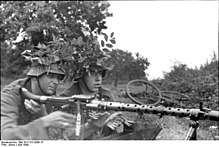
2,300 MG 34s, slightly different from the final design, were produced between 1935 and 1939. At the time it was introduced, it had a number of advanced features and the general-purpose machine gun concept that it aspired to was an influential one. The gun was eventually adopted for main service on 24 January 1939.[15]
The MG 34 was used as the primary infantry machine gun, and remained as the primary armored vehicle defensive weapon as it took limited space to change barrels inside a vehicle. The MG 34 was intended to replace the MG 13 and other older machine guns, but these were still being used in World War II as demand was never met.[16] It was intended to be replaced in infantry service by the MG 42, but there were never enough MG 42s, and MG 34s soldiered on in all roles until the end of World War II.[17]
It was the standard machine gun of the Kriegsmarine (German Navy)[18] and was also used as a secondary weapon on several German tanks.[17]
Use in East Asia
MG 34s captured by the British and Soviet armies were sent to both Chinese Nationalist and Chinese Communist forces during both World War II and the Chinese Civil War.[19] The French army sent captured MG 34s to Indochina during the Indochina War.[20] Some models captured from the Germans by the Soviets or manufactured in Czechoslovakia post-WWII were supplied to the People's Liberation Army/People's Volunteer Army,[19] PAVN and the Viet Cong during the Cold War.[21] Several hundred more MG 34s that were in use with these groups were taken from either French or other Western nations fielding captured German weapons fighting against them in colonial wars or anti-communist conflicts.
Today a MG 34 can be found in the Military Museum of the Chinese People's Revolution which was captured from the Chinese Nationalist Army during the Chinese Civil War.
German small arms doctrine
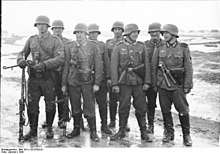
While the Americans had standardized a semi-automatic rifle in 1936 (the M1 Garand), the German military kept issuing Karabiner 98k bolt-action rifles due to their tactical doctrine of basing a squad's firepower on the general-purpose machine gun in the light machine gun role so that the role of the rifleman was largely to carry ammunition and provide covering fire for the machine gunners. The advantage of the general purpose machine gun concept was that it added greatly to the overall volume of fire that could be put out by a squad-sized unit.[22][23] The German military did experiment with semi-automatic rifles throughout World War 2 and fielded the Gewehr 41 series of which less than 150,000 were built, the Gewehr 43/Karabiner 43 series of which 402,713 were built, and introduced the first assault rifle in 1943 – the MP43 / MP44 / StG 44 series, of which 425,977 were built. Due to the relatively limited production of semi-automatic and assault rifles, the Karabiner 98k of which over 14,600,000 were built remained the primary service weapon until the last days of World War 2, and was manufactured until Germany's surrender in May 1945.
Medium machine gun fire support role
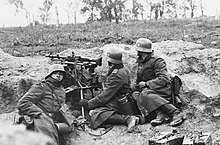
In the German heavy machine gun (HMG) platoons, each platoon served four MG 34/MG 42 machine guns, used in the sustained fire mode mounted on tripods.[24] In 1944 this was altered to six machine guns in three sections with two seven-man heavy machine gun squads per section as follows:
- Squad leader (NCO) MP40
- Machine gunner (private) MG 34/MG 42 and pistol
- Assistant gunner (private) pistol
- Three riflemen (privates) rifles
- Horse leader for horse, cart and trailer (private) rifle
Characteristics
The MG 34 fires from an open bolt and this format both keeps the barrel open at both ends after firing ceases, allowing airflow through it and helping it to cool faster, and meanwhile retains the next unfired bullet outside the chamber until the trigger is squeezed again; and thus the cartridges are protected from the risk of cook-offs from high chamber temperatures after long bouts of sustained automatic fire. The firearm was designed with a rotating bolt operated by short recoil aided by a muzzle booster. When the firearm is ready to fire the bolt is pulled back to the rear and is held back by the sear. With the pull of the trigger the sear disengages sending the bolt forward under pressure from the recoil spring. A cartridge is stripped from the magazine or belt and the round is pushed into the chamber. As the bolt moves forward into battery the bolt rotates engaging the locking lugs and chamber locking the bolt to the barrel. The striker strikes and ignites the primer and the round is fired. The recoil causes the barrel and bolt to move backwards a short distance. The rearward movement of the barrel causes the rotating bolt to rotate back disengaging the locking lugs and unlocking the bolt from the barrel. The barrel returns to its forward position while the bolt recoils to its rear position. The empty casing is ejected and the cycle can begin anew.[25]
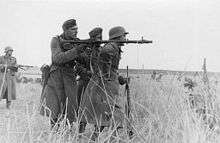
The MG 34 came with a standard iron sight line consisting of a notched 'V' sight mounted to a post in the rear and a single blade at the front. The sight came calibrated for ranges between 200 and 2,000 m (219 and 2,187 yd) in 100 m (109 yd) meter increments.[26] The standard sight line had a 530 millimeters (20.9 in) sight radius. The MG 34 could accept a variety of different sighting systems, such as an anti-aircraft sight[27] or telescopic sights for use in specialty roles.
The MG 34 could use non-disintegrating metallic-link belts. The feeding system was based on the direct push-through of the cartridge out of the link into the gun’s chamber. Accordingly, the link had to be of the half-open type to enable the motion of the bolt through the link. Belts were supplied in a fixed length of 50 rounds, but could be linked up to make longer belts for sustained firing. A 250-round belt was also issued to machine guns installed in fixed emplacements such as bunkers. Ammunition boxes contained 250 rounds in five belts that were linked to make one continuous 100 round belt and one 150 round belt. The other feed options were assault drums that contained a coiled a 50-round belt, or a 75-round "double drum" magazine could be used by replacing the top cover with one made specially for that purpose. A gun configured to use the 75-round magazine could not be returned to belt-feed mode without changing the top cover again.[28]
The barrel of the MG 34 could be quickly changed to avoid overheating during sustained fire by the machine gun crew and weighed 2 kg (4.4 lb). During a barrel change, the operator would disengage a latch on the left side of the receiver which held the receiver to the barrel sleeve. The entire receiver section could then pivot off to the right on its latitudinal axis, allowing the operator to pull the barrel out the back of the sleeve. A new barrel would then be put in the back of the sleeve, and the receiver rotated back in line with the barrel sleeve and latched. The entire process took just a few seconds when performed by a well-trained operator, causing minimal downtime in battle.[28] The butt-stock could be easily removed to reduce the space occupied when mounted inside a vehicle.
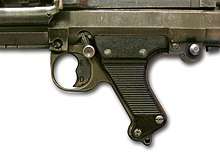
A unique feature of the MG 34 was its double-crescent trigger, which provided select fire capability without the need for a fire mode selector switch. Pressing the upper segment of the trigger produced semi-automatic fire, while holding the lower segment of the trigger produced fully automatic fire.[29] Though considered innovative at the time, the feature was eliminated due to its complexity on the MG 34's successor, the MG 42.[30]
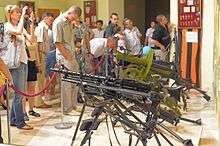
In the light machine gun role, it was used with a bipod and weighed only 12.1 kg (26.7 lb). In the medium machine gun role, it could be mounted on one of two tripods, a smaller one weighing 6.75 kg (14.9 lb), the larger Lafette 34 23.6 kg (52.0 lb).
Lafette 34 tripod
For the medium machine gun role a larger tripod, the MG 34 Lafette 34, included a number of features, such as recoil absorbing buffer springs, MG Z 34 or MG Z 40 periscope-type telescopic sight containing special sighting equipment for indirect fire or the late World War II MG Z 44, designed for direct fire only. An accessory to lengthen these sights' periscope was available, allowing the use of them behind cover. It could be set up in a prone, kneeling or a high position and weighed 20 kg (44.1 lb) on its own. The legs could be extended with a Lafetteaufsatzstück to allow it to be used in the low level anti-aircraft role, and when lowered, it could be placed to allow the gun to be fired "remotely" while it swept an arc in front of the mounting with fire. Mounted to the Lafette and aimed through the telescopic sight the effective range of the MG 34 could be extended out to 3,500 m (3,828 yd) when fired indirectly. The Lafette 34 tripod also had a bolt box to store a (spare) bolt.[31][32]
Another unique feature of German World War II machine guns was the Tiefenfeuerautomat feature on the Lafette 34 tripod. If selected, this feature mechanically controlled the rise and fall of the gun, elevating the gun for five rounds and then depressing it for four rounds. It lengthened the beaten zone by walking the fire in wave like motions up and down the range in a predefined area. The length of the beaten zone could be set on the Tiefenfeuerautomat. E.g., being unsure whether the real distance was 2,000 or 2,300 m (2,187 or 2,515 yd), the gunner could make the mount do an automatic sweep between the elevations for 1,900 to 2,400 m (2,078 to 2,625 yd) and back. This sweeping of a selected beaten zone continued as long as the gun fired. The Lafette 34 had a Richt- und Überschießtafel (Overhead firing table) riveted to the rear body of the searchfire mechanism from the very start of production until the very end of it. In the later stages of World War II ballistic correction directions were added for overshooting friendly forces with S.m.E. – Spitzgeschoß mit Eisenkern (spitzer with iron core) ammunition of which the external ballistic behaviour started to significantly deviate from 1,500 m (1,640 yd) upwards compared to the s.S. Patrone (s.S. ball cartridge).[33][34][35]
Variants
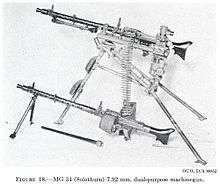
.jpg)
MG 34/41 (MG 34S)
The MG 34/41 was requested as the first war experiences in the beginning of World War II proved that a higher fire rate generates more dispersion of the bullets. The MG 34/41 could cope with a cyclic fire rate of 1,200 rounds per minute but its components became highly stressed.[17] The weight of the MG 34/41 was 14 kg, slightly more than the original MG 34 version. 300 MG 34/41 were produced and were sent to the Russian front in 1942. The MG 34/41 was beaten in trials by the MG 39/41, later designated MG 42.[17]
MG 34 Panzerlauf
Most German tanks used during World War II used the MG 34[36] Panzerlauf for secondary armament. The MG 42 was ill-suited for internal/coaxial mounting due to the method of barrel change. The MG 42's barrel had to be removed and replaced by sliding the barrel out at an angle such that, when mounted on a tank/armoured vehicle, armour and space would have to be compromised to fit the weapon. Although the MG 34 was older than the, arguably, improved MG 42, its barrel could be swapped in-line with the gun, meaning that the MG 34 was favoured because of the fact that it was simpler to design mountings for the gun. The MG 34 was also easier to feed, for instance using a drum magazine or being select-fire.[37]
The main difference of the MG 34 Panzerlauf and the regular MG 34 was the heavier, almost solid armored barrel shroud, almost completely lacking the ventilation holes of the basic MG 34.[38] When mounted inside a tank, the MG 34 also lacked a butt-stock. A kit for quick conversion to ground use was carried inside the tank containing a butt-stock and a combined bi-pod and front sight assembly.[38]
MG 81
The MG 34 was also used as the basis of a new aircraft-mounted machine gun, the MG 81 machine gun. For this role, the breech was slightly modified to allow feeds from either side, and in one version, two guns were bolted together on a single trigger to form a weapon known as the MG 81Z (for Zwilling, German for "twin" as in twin-mounted). Production of the MG 34 was never enough to satisfy any of its users, and while the MG81 was a significant improvement over the earlier MG 30-based MG 15 and MG 17 guns, these guns were used until the end of the war. As the Luftwaffe lost the battle for air superiority and declined in priority in the German war effort, MG 15s and MG 81s, which were designed as flexibly mounted aircraft machine guns, were modified and adapted for ground use by infantry, with varying degrees of success.
MG34F1 and MG34F2
Norway used and first converted the MG 34 in the 1950s to .30-06 Springfield designated as the MG34F1 and later to 7.62×51mm NATO designated as the MG34F2. These converted MG 34's were used by the Heimevernet (Norwegian Home Guard) until the mid 1990s.[39]
TNW MG34
The TNW MG34 is a closed bolt, semi automatic only version of the MG34 made by TNW firearms, due to the high cost and rarity of the full auto versions. Although they stopped production in 2018, there are still a number of these still being sold on their website and others as well. They will also continue to make part kits for their semi auto MG34.
Users




.svg.png)


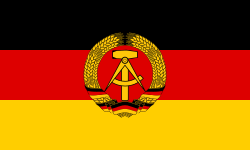


.svg.png)

.svg.png)

.svg.png)

%3B_Flag_of_Syria_(1963%E2%80%931972).svg.png)

.svg.png)
See also
- List of World War II firearms of Germany
- MG 30, predecessor
- MG 42, successor
- MG 3
- MG 81 machine gun
- SIG 710-3
References
- McNab, Chris (20 Oct 2012). MG 34 and MG 42 Machine Guns. Weapon 21. Osprey Publishing. ISBN 9781780960081.CS1 maint: ref=harv (link)
- Russell, Lee; Katz, Sam (April 1986). Israeli Defense Forces, 1948 to the Present. Uniforms Illustrated 12. Olympic Marketing Corp. p. 15. ISBN 978-0853687559.
- "Syrian Civil War: WWII weapons used". wwiiafterwwii.wordpress.com. June 27, 2017.
- Folke Myrvang (2003), MG34-MG42: German Universal Machineguns, Collector Grade Publications Incorporated, ISBN 088935278X, 9780889352780
- Encyclopedia of Weapons of World War II. p. 246.
- Jane's Guns Recognition Guide. Ian Hogg & Terry Gander. HarperCollins Publishers. 2005. page 375
- Military Small Arms of the 20th Century. 7th Edition. Ian V. Hogg & John S. Weeks. Krause Publications. 2000. page 326
- The Encyclopedia of Weapons of World War II. Chris Bishop. Sterling Publishing Company. 2002. page 245 & 246
- Haskew, Michael E (2012). Small Arms 1914–1945: The Essential Weapons Identification Guide. London: Amber Books. p. 92. ISBN 978-1-908273-85-7.
- Smith, Joseph E. (1973). Small Arms of the World (10th ed.). Harrisburg, PA, USA: Stackpole Co.
- Filling and Adjusting the PT34
- Patronentrommel 34
- Feeding the Tiger By Jean-François Legendre Ammunition Belts for German MG 34 and MG 42 Machine Guns
- Haskew 2012. pp. 146.
- Haskew 2012. pp. 85.
- McNab 2012, p. 13.
- Smith, Joseph E (1973). Small Arms of the World (10th ed.). Harrisburg, PA, USA: Stackpole Company. p. 137.
- McNab 2012, p. 17.
- McNab 2012, p. 61.
- McNab 2012, p. 69.
- Ezell, Edward Clinton (1988). Personal firepower. The Illustrated history of the Vietnam War 15. Bantam Books. pp. 34, 41. OCLC 1036801376.
- McNab 2012, p. 70.
- Hogg, Ian V., & Weeks, John. Military Small-Arms of the 20th century (London: Arms & Armour Press, 1977), p.183, "US Rifle, Caliber .30in ('Garand'), M1-M1E9, MiC, M1D, T26".
- OSPREY. Elite PUBLISHING. World War II Infantry. Tactics. Squad and Platoon. p. 22-23 Dr. Stephen Bull, OSPREY. Elite PUBLISHING
- Murray, Dave. "The German Infantry Platoon". avalanchepress.com. Avalanche Press. Retrieved 18 February 2017.
- McNab 2012, pp. 14–15.
- McNab 2012, p. 42.
- McNab 2012, p. 56.
- McNab 2012, p. 15.
- McNab 2012, p. 14.
- McNab 2012, p. 20.
- McNab 2012, pp. 49–51.
- Lafette 34 & 42
- The evolution of the Lafette 34
- Maschinengewehr 34, Teil 2, MGLafette 34, Beschreibung, Handhabung und Behandlung vom 5.3.43
- "The Überschießtafel". www.bergflak.com.
- McNab 2012, p. 57.
- McNab 2012, p. 58.
- McNab 2012, p. 59.
- MG34 and MG42 in Norway, Post WW2, by Folke Myrvang
- Jowett, Philip (2016). Modern African Wars (5): The Nigerian-Biafran War 1967–70. Oxford: Osprey Publishing Press. p. 23. ISBN 978-1472816092.
- Brnardic, Vladimir (17 Nov 2016). World War II Croatian Legionaries: Croatian Troops under Axis Command 1941–45. Men-at-Arms 508. Osprey Publishing. p. 5. ISBN 9781472817679.
- Perutka, Lukáš (September 2014). Checoslovaquia, Guatemala y México en el Período de la Revolución Guatemalteca: Ibero-Americana Pragensia – Supplementum 32/2013 (in Spanish). Karolinum Press. p. 110. ISBN 978-80-246-2429-7.
- Rada, Tibor (2001). "Német gyalogsági fegyverek magyar kézben" [German infantry weapons in Hungarian hands]. A Magyar Királyi Honvéd Ludovika Akadémia és a Testvérintézetek Összefoglalt Története (1830–1945) (in Hungarian). II. Budapest: Gálos Nyomdász Kft. p. 1114. ISBN 963-85764-3-X.
- McNab 2012, pp. 69-70.
- http://www.nam-valka.cz/zbrane/mg34.html
- MG34 and MG42 in Norway, Post WW2, by Folke Myrvang
- https://silahreport.com/2018/08/07/small-arms-captured-by-saa-during-operation-basalt/
- Scarlata, Paul (1 October 2017). "Yugoslav Part II: World War II small arms: an assortment of small arms from friends and foe alike". Firearms News.
- Vukšić, Velimir (July 2003). Tito's partisans 1941–45. Warrior 73. Osprey Publishing. p. 25. ISBN 978-1-84176-675-1.
External links
| Wikimedia Commons has media related to MG34 (machinegun). |
- MG 34 - Modern Fireams
- 1943 U.S. Intelligence Report
- US Army training video about the MG 34 from YouTube
- The Pacific War 5: Chinese Infantry Weapons
- Maschinengewehr 34, Beschreibung, Handhabung und Behandlung, Teil 1, Waffe vom 1.8.40
- MG 34, Military Intelligence Service, Special Series No. 14, May 25, 1943, U.S. War Department
- MG 34 (Maschinengewehr 34) : First universal machine gun